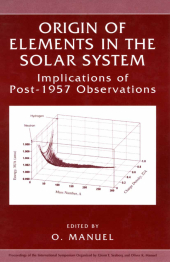 Neuerscheinungen 2013Stand: 2020-01-07 |
Schnellsuche
ISBN/Stichwort/Autor
|
Herderstraße 10
10625 Berlin
Tel.: 030 315 714 16
Fax 030 315 714 14
info@buchspektrum.de |

Oliver K. Manuel
Origin of Elements in the Solar System
Implications of Post-1957 Observations
Herausgegeben von Manuel, Oliver K.
2002. 2013. xxi, 646 S. 44 SW-Abb., 2 Farbabb. 254 mm
Verlag/Jahr: SPRINGER, BERLIN; SPRINGER US 2013
ISBN: 1-475-77315-3 (1475773153)
Neue ISBN: 978-1-475-77315-6 (9781475773156)
Preis und Lieferzeit: Bitte klicken
Based on an American Chemical Society Symposium organized by Professors Glenn Seaborg and Oliver Manuel, this volume provides a comprehensive record of different views on this important subject at the end of the 20th century. They have assembled a blend of highly respected experimentalists and theorists from astronomy, geology, meteoritics, planetology and nuclear chemistry and physics to discuss the origin of elements in the solar system. The intent was to include all points of view and let history judge their validity.
Contributors. Acknowledgements. Preface and Dedication. Part I: Glenn Seaborg and the Quest for Superheavy Elements. Ghiorso Remembers Seaborg; A. Ghiorso. Superheavy Elements at Berkeley: The Culmination of Seaborg´s Career; K.E. Gregorich, V. Ninov. The Discovery of Superheavy Elements 107-112 and of the Deformed Shell at N = 162; P. Armbruster. Part II: The Nuclear Reactions that Made our Elements. The Decay of 19N; D.W. Anthony, et al. Measuring the Astrophysics Rate of the 21Na(p,gamma)22Mg Reaction; J.M. D´Auria for the Dragon Collaboration. Production and beta-Decay Half-Lives of Very N-Rich Nuclei; M. Bernas. The Role of the N = 28 and N = 40 Closed Shells in the Production of the Neutron-Rich Ca-Ti-Cr-Fe-Ni Elements in the Universe; O. Sorlin. Experimental Studies Related to s-Process Abundances; K. Wisshak, et al. Neutron Capture Cross Section Measurements for the Analysis of the s-Process; R.S. Rundberg, et al. About the Reliability of Extrapolation of Nuclear Structure Data for r-Process Calculations; G. Lhersonneau, et al. The Astrophysical r-Process; K.-L. Kratz, et al. Nuclear Aspects of Stellar and Explosive Nucleosynthesis; T. Rauscher, et al. Proton Captures in the Atmosphere of Accreting Neutron Stars; H. Schatz, et al. Part III: A Cosmological View of Nucleosynthesis. The Origin of the Elements; G. Burbidge. Chemical Evolution Tomorrow; V. Trimble. LiBeB Nucleosynthesis and Clues to the Chemical Evolution of the Universe; V.E. Viola. Measurement of the 44Ti Half-life and its Significance for Supernovae; I. Ahmad, et al. On the Half-Life of 44Ti in Young Supernova Remnants; E.B. Norman, E. Browne. Abundancesin SN 1987A and other Supernovae; R.A. Chevalier. The Birth of Planetary Systems Directly from Supernovae W.K. Brown. Bipolar Outflows in Stellar Astrophysics; A. Frank. Part IV: Nuclides in the Sun. Mini-blackhole at the Solar Centre and Isotopic Abundances in the Primitive Solar Nebula; S. Ramadurai. Abundances of the Elements in the Sun; N. Grevesse, A.J. Sauval. Isotopic Ratios: The Key to Elemental Abundances and Nuclear Reactions in the Sun; O. Manuel. Critical Evaluation of CI Chondrites as the Solar System Standard of Elemental Abundances; M. Ebihara, et al. Sensitivity of Solar Oscillation Frequencies to Element Abundances; J.A. Guzik, C. Neuforge. Inverse and Forward Helioseismology: Understanding the Interior Composition and Structure of the Present Sun; C.A. Rouse. Heterogeneous Accretion of the Sun and the Inner Planets; G. Hwaung. Interstellar Matter, Sun, and the Solar System; M.N. Vahia, D. Lal. Part V: Nuclides in the Sun´s Planetary System. Isotope Anomalies in Tellurium in Interstellar Diamonds; R. Maas, et al. Isotope Abundance Anomalies in Meteorites: Clues to Yields of Individual Nucleosynthesis Processes; U. Ott. Variation of Molybdenum Isotopic Composition in Iron Meteorites; Q. Lu, A. Masuda. Iron Meteorites and Paradigm Shifts; E.C. Alexander, Jr. Chronology of Early Sonar System Events: Dating with Short-lived Nuclides; J.N. Goswami. Xenology, FUN Anomalies and the Plutonium-244 Story; P.K. Kuroda, W.A. Myers. Extinct 244Pu: Chronology of Early Solar System Formation; M.W. Rowe. A Search for Natural Pu-244 in Deep-Sea Sediment: Progress Report; K. Sakamoto, et al. Strange Xenon Isotope Ratios in Jupiter; K. Windler. Abundances of Hydrogen and Heliu


